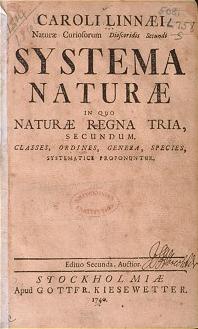Carl (von) Linné (Carolus Linnaeus)
Botanist and explorer, b. 23 May 1707 (Råshult, Sweden), d. 10 January 1778 (Uppsala).
 Carl Linné, the son of a curate, developed an interest in plants at an early age; by the time he had reached eight years of age he was known as "the little botanist." He studied medicine at the universities of Lund and Uppsala, where he obtained his degree, but soon returned to biology. In 1730 he was appointed lecturer in botany.
Carl Linné, the son of a curate, developed an interest in plants at an early age; by the time he had reached eight years of age he was known as "the little botanist." He studied medicine at the universities of Lund and Uppsala, where he obtained his degree, but soon returned to biology. In 1730 he was appointed lecturer in botany.
In 1732 Linnaeus obtained support from the Uppsala Academy of Science for an expedition to Lapland. Compared to the great expeditions of the time Linnaeus' trip was a relatively modest undertaking, but he described the collected plants with great accuracy in his work Flora Lapponica, which was published in Amsterdam in 1737 and translated more than 70 years later into English by J. E. Smith as Lachesis Lapponica (1811).
The work established its author as a leading botanist. Linnaeus had set himself the task to bring order into the tens of thousands of plants that were known but not systematically classified. Over a period of twenty years he wrote several works for that purpose and refined his classification. Important works in this regard were
- Systema Naturae in 1735,
- Genera Plantarum in 1737,
- Species Plantarum in 1753,
- Genera Plantarum in fifth edition in 1754.
While following his botanical interests Linnaeus in 1738 opened a successful practice as a physician in Stockholm. In 1741 he was appointed to the chair of medicine at the University of Uppsala, which he could exchange in the following year against the chair in botany.
Linnaeus was honoured for his work during his lifetime. His Systema Naturae impressed the botanist Jan Fredrik Grovonius, who had seen it in manuscript form, to such an extent that he had it printed at his own expense. In 1755 the Spanish king invited Linnaeus to settle in Spain on a good salary and liberty of conscience, but Linnaeus declined. In 1761 he was granted Swedish nobility, antedated to 1757, and allowed to call himself Carl von Linné.
Linnaeus' classification of plants and animals was designed in the style of a guide for the determination of species. It was therefore based on easily recognizable identifying parts (such as flowers) and did not group species according to evolutionary relationships. Linnaeus himself did not see evolution in plants; he considered nature as static and devised his classification merely to get order into existing confusion. His now obsolete system of sexual classification for plants was ridiculed and the object of protest during his lifetime. Others, such as Erasmus Darwin, acknowledged Linnaeus as the discoverer of pollination as a system of sexual reproduction.
His lasting contributions to biology were the discovery of sexual reproduction in plants and the binomial classification, which is still used today. Before Linnaeus biologists referred to plants with many names (polynomials). Linnaeus standardized the nomenclature by introducing the principle of genus, combined with the specific name. Thus, the white oak received the scientific name quercus alba, which means that it belongs to the genus quercus (oak) and has the specific name alba (white). By international agreement today's system of biological classification of flowering plants and ferns is based on the first edition of Species Plantarum and the fifth edition of Genera Plantarum.
The Linnean Society in London acts as the custodian of Linnaeus' manuscripts, his herbarium and his collections of insects and shells.
References
Salisbury, E. J. (1995) Carolus Linnaeus. Encyclopaedia Britannica 15th ed.
Waggoner, B. Linnaeus. http://www.ucmp.berkeley.edu/history/linnaeus.html (accessed 18 April 2004)

Title page of the second edition of Systema Naturae
home
 Carl Linné, the son of a curate, developed an interest in plants at an early age; by the time he had reached eight years of age he was known as "the little botanist." He studied medicine at the universities of Lund and Uppsala, where he obtained his degree, but soon returned to biology. In 1730 he was appointed lecturer in botany.
Carl Linné, the son of a curate, developed an interest in plants at an early age; by the time he had reached eight years of age he was known as "the little botanist." He studied medicine at the universities of Lund and Uppsala, where he obtained his degree, but soon returned to biology. In 1730 he was appointed lecturer in botany.